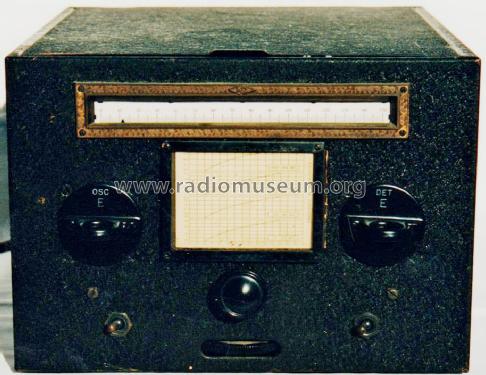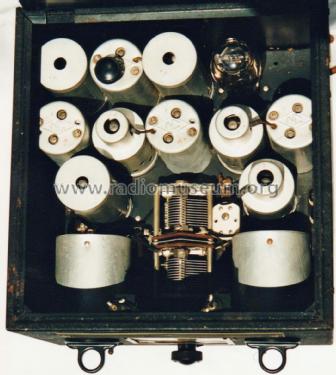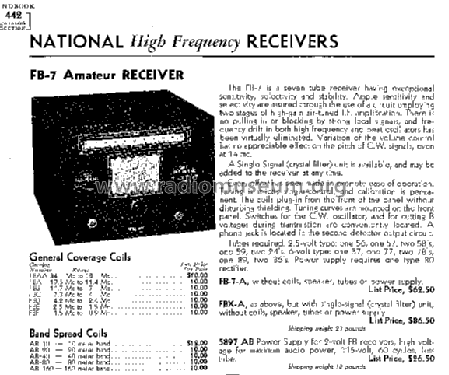FB-7 var 1 (2,5 V tubes)
National Company; Cambridge & Malden (MA)
- Produttore / Marca
- National Company; Cambridge & Malden (MA)
- Anno
- 1933/1934 ?
- Categoria
- Ricevitore amatoriale (può includere bande broadcast)
- Radiomuseum.org ID
- 85422
-
- alternative name: National Toy Co.
- Brand: Thrillbox
Clicca sulla miniatura dello schema per richiederlo come documento gratuito.
- Numero di tubi
- 7
- Principio generale
- Supereterodina (in generale); ZF/IF 500 kHz
- Gamme d'onda
- Onde corte (solamente OC)
- Tensioni di funzionamento
- Alimentazione a corrente alternata (CA)
- Altoparlante
- - Per cuffie o amplificatori esterni
- Materiali
- Mobile di metallo
- Radiomuseum.org
- Modello: FB-7 [var 1 ] - National Company; Cambridge &
- Forma
- Soprammobile con qualsiasi forma (non saputo).
- Annotazioni
- version with 2,5V-heated tubes and compression mica IF transformers:
coverage 1500 - 20000 kHz (coils FB A-E), 800 - 34000 kHz (with optional coils FB AA-F), 20 - 160 m amateur bands (with optional bandspread coils AB 20-160);
optional external RF preselector;
optional external power supplies 5880AB, 5887AB or high voltage 5897AB
- Prezzo nel primo anno
- 55.00 $
- Fonte dei dati
- Communications Receivers
- Autore
- Modello inviato da Martin Bösch. Utilizzare "Proponi modifica" per inviare ulteriori dati.
- Altri modelli
-
In questo link sono elencati 446 modelli, di cui 285 con immagini e 189 con schemi.
Elenco delle radio e altri apparecchi della National Company; Cambridge & Malden (MA)
Musei
Il modello può essere visto nei seguenti musei.
Discussioni nel forum su questo modello: National Company;: FB-7
Argomenti: 2 | Articoli: 2
The first ad for the FB-7 in QST was March 1933. The phone jack, hot with B+ on both the exterior of the jack and the inside, is visible on the left front of the ad pic. Almost immediately after introducing the set, a change was made to IF transformers wound with Litz-wire and with air dielectric trimmer caps to replace the simpler compression types. Those new IF transformers were also offered as individual components as shown in the full page ad in May 1933 QST. Another change was quickly made to add a second switch on the front panel for the B+ replacing the phone jack, also shown for the first time in the May 1933 issue. National's ads describe that switch as “for transmitting” which was true since it placed the set in “standby” mode, but the other reason likely had to do with hot-switching the coils. With live B+ in the set, pulling out the oscillator coil which had a grounded aluminum finger-pull handle might release the ground contact before the other contacts. Holding on to the chassis to keep it from moving while pulling out the coil might cause an unpleasant surprise. Better to throw that B+ switch first. The hot phone jack migrated to the back panel. Models with suffix “A” versions of the FB-7 and FBX were introduced shortly afterward with the improved IF coils and that second front panel switch which replaced the front panel phone jack, quickly followed by pictures of a model with the internal BFO knob. I'm convinced that nearly all surviving FB-7 and FBX sets are the “A” versions.
Allegati
- First QST ad for FB-7 March 1933 (169 KB)
- Ad for Air dielectric IFs in QST May 1933 (259 KB)
Rich Post, 21.Jun.21
If you have Raymond Moore's book, Communications Receivers: The Vacuum Tube Era, you will find model listing for both FB-7 and FB-7A (and FBX and FBXA) receivers in the National section. He list the difference between the two as the FB-7A having air-tuned IF transformers, and the FB-7 as having mica tuned IF transformers. I have owned FB-7's in the past, and never really bothered to check whether the IF transformers were air versus mica.
While researching FB-7 coil information, I noticed that National used the nomenclature "FB-7" and "FB-7A" interchangeably. For instance, the National Bulletin No. 220 has two pages on the "FB-7". The first page is headed as, "National 'FB-7' Amateur Type Short Wave Receiver." However, at the bottom of the page, where the price is listed, they use the nomenclature "FB-7A" with no listing for a "FB-7." This continued in Bulletin No. 240 (1934) and No. 260 (1936).
The same thing with the National FBX-A. There is no listing for a "FBX" model.
I think where the confusion comes in is that National lists both air-tuned (XR-39A) and mica tuned (XR-39M coil forms, starting with bulletin No. 240. But the Bulletin No. 220 specifically says the FB-7 oscillator coil is "air padded."
This would not be the first mistake found in Communications Receivers. I will always have a fondness for this most useful book, but to say the book's information is 100% correct would be misleading at best. And depending on which edition (there are four) you have, the information can be way off for some models. If you read the introduction to the book, you realize that Mr. Moore was working mainly with QST magazines and ARRL handbooks. The nomenclature "FB-7" was used extensively in National advertising in 1934, as the "FB-7" was prevalent in 1934 issues of QST. So, it would be easy to see how this mistake couldd be made, if in fact, it is a mistake.
Also, it would be interesting to know what benefit that the mica or air tuned transformers have. Obviously, the mica tuned transformers would be cheaper to produce, but not at a significant reduction to make a huge difference in the cost of the receiver. And it was never National's policy to take the cheap way out. It would also appear that the air tuned transformers would perform better.
So, given that National never lists a price for a model "FB-7", but does for the "FB-7A," and their use of the nomenclature FB-7 and FB-7A to refer to the same model, can we assume that only air-tuned FB-7's exist and there has never been a "FB-7" mica tuned model?
It would be interesting to know if anyone has an FB-7 that has mica tuned IF transformers. Of course, this would require disassembly of the transformer.
Allegati
Wayne Childress, 15.Dec.16




